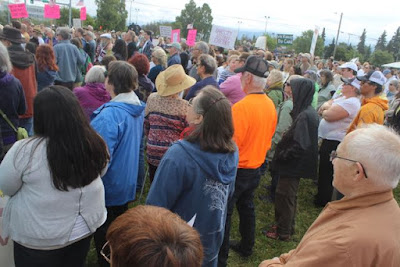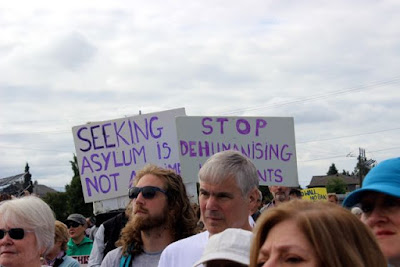I wrote Wednesday that the Anchorage International Airport has a temporary new flight plan sending noisy jets over our house throughout the day and night. In the past we've had three or four week periods like this as they repaired the north-south runway. But there was always a quiet period during the night.
This year's repairs are scheduled for all summer and next summer and there's no night quiet period either. (The posting said the heaviest planes would have to use the east-west runway 24/7)
So I looked at their map.
The dotted red lines shows the area labeled:
During Construction 65 DNL Noise Contour
I added the blue dashes to show how far significant (at least) noise goes beyond those red dots. I'd also note there are two major hospitals just east of where I ended the blue dots that definitely are affected.
They don't explain DNL, but I have google working for me. Below is a
definition of DNL from MACNoise:
"What is DNL in Terms of Aircraft Noise?
The Federal Aviation Administration (FAA) established DNL as the primary metric for aircraft noise analysis and expressing aircraft noise exposure in the United States. "DNL" is the acronym for Day-Night Average Sound Level, which represents the total accumulation of all sound energy, but spread out uniformly over a 24-hour period.
DNL has been widely accepted as the best available method to describe aircraft noise exposure and is the noise descriptor required by the FAA for use in aircraft noise exposure analyses and noise compatibility planning. It also has been identified by the U.S. Environmental Protection Agency as the principal metric for airport noise analyses.
The calculation for DNL considers the time of day an aircraft operated and applies a 10-decibel penalty on aircraft arriving or departing between 10 p.m. and 7 a.m.; the output is a numeric value in decibels that represents a 24-hour average noise exposure value. The current federally-established threshold of significance is 65 dB DNL.
While DNL also may be used for non-aviation purposes, the FAA's use of DNL is specific to aircraft noise. The Metropolitan Airports Commission publishes Aircraft Day-Night Level values as "ADNL" to avoid confusion with other uses of "DNL."
The threshold is 65 dB (decibels) DNL. That doesn't mean the sound level stays below 65 dB. It means the average over a 24 hour period is 65 dB.
So if on average you have ten minutes per hour of jets flying over your house, it would appear that decibel level is averaged with the 50 minutes of quiet. So, from what that definition says, you could have ten minutes of 120 dB per hour and probably still get a 65 dB DNL. (I'm not sure, I don't know exactly how they calculate. How does the fact that the decibel scale goes up
logarithmically affect an 'average'?)
Decibels
How loud is 65 dB DNL? Here's a
google docs chart that shows you lots of examples. It puts washing machine, dishwasher, and refrigerator at 65 dB and electric shaver at 65. If linking to the google chart is too much of an effort, I've added a chart from SCRIBD that has some extra pages of info. You can scroll through it and enlarge it. (Note: the examples in the Google and SCRIBD charts don't always match exactly, and the SCRIBD charts has different examples on different pages)
As you look at the chart, the numbers aren't going to seem right. For instance, here are a few examples:
breathing = 10 decibals
light traffic = 50 decibels
inside subway car = 90 decibels
Is light traffic really only 5 times louder than breathing? A subway car only 9 times louder? The answer is no. And here's why
from Science How Stuff Works:
"On the decibel scale, the smallest audible sound (near total silence) is 0 dB. A sound 10 times more powerful is 10 dB. A sound 100 times more powerful than near total silence is 20 dB. A sound 1,000 times more powerful than near total silence is 30 dB. Here are some common sounds and their decibel ratings:"
Here's where the logarithmic scale is important. Each step of 10 decibels is 10 TIMES louder than the previous step. So, if light traffic is 40 decibels more than breathing, then that's 10 x 10 x 10 x 10 =
10,000 times louder!
The SCRIBD chart tells us that hearing loss can start at 90 decibels - a subway. Permanent damage occurs at 140 decibels - a jet engine at 100 feet or a gun shot.
Noise and Health
There's lots of research showing the damaging effects of noise on health - though be careful with what you find online. I found one article which made pretty broad claims, but the sources cited were extremely limited studies on fairly small populations. While the claims were probably accurate, the sources listed couldn't be generalized to such broad claims. So I didn't use it here.
But
here's an article* about noise impacts at an airport in Turkey using European standards. It has this chart which neatly outlines some of the key problems with airport noise. The metrics are European standards
| Effect | Observation threshold |
|---|
| Metric | Value dB(A) |
|---|
| Hypertension | Lden | 70 |
| Ischemic heart disease | Lden | 70 |
| Performance | Ln | 70 |
| Sleep pattern | Ln | 60 |
| Subjective sleep quality | Ln | 40 |
| Mood next day | Ln | 60 |
Below are the first seven of ten Key Findings from the
European Environment Agency report Noise In Europe 2014.
The key messages from this report are:
1. noise pollution is a major environmental health problem in Europe;
2. road traffic is the most dominant source of environmental noise with an estimated 125 million people affected by noise levels greater than 55 decibels (dB) Lden (day-evening-night level);
3. environmental noise causes at least 10 000 cases of premature death in Europe each year;
4. almost 20 million adults are annoyed and a further 8 million suffer sleep disturbance due to environmental noise;5. over 900 000 cases of hypertension are caused by environmental noise each year;
6. noise pollution causes 43 000 hospital admissions in Europe per year;
7. effects of noise upon the wider soundscape, including wildlife and quiet areas, need further assessment;
I'm not sure whether Lden is the same calculation as DNL, but Europe's threshold seems to be 55 dB while ours (US) is 65.
Is this post going to end?
Basically, I've been taking notes here so I have some basis for raising questions about the decision to impose this level of noise on a big chunk of Anchorage for four months. Two days into this and I'm already on edge. Jets flying over all night - even with heavy duty ear plugs in - is affecting my sleep and there are all the other stress issues the studies show. The DNL numbers are one way to measure this, but are they the best way? The average sound is important for long term steady health impacts. But in terms of health, I would guess that measuring the loudest sounds and how often people subjected to them is equally or more important. It's hard to sleep through occasional 120 dB periods (rock concert is listed as 115 dB) all night.
I understand the airport makes a lot of money from cargo flights through the airport and disrupting that may encourage cargo companies to fly through Fairbanks instead of Anchorage. Maybe the heaviest cargo planes that can't use the shorter north-south runway should go through Fairbanks at night. Maybe they should give a discount to flights that are delayed during a night time east-west runway ban. I don't know the answer. But it doesn't look like health and inconvenience played nearly as big a role in their calculations as keeping the money rolling into the airport. That's not a small matter, or course, but for a big swath of Anchorage to have its summer disrupted by continuous jet noise is no small matter either. The
Municipality's dog noise page tells us that:
"Few things in life are as annoying as having to listen to the constant bark, howl, whine or cry of another person's dog."
Well, constant loud airplane noises can be just as annoying.
This is my starting point. Let's see what I find out.
And I would add that it's Friday now. Thursday night seemed to have fewer flights and with my earplugs I made it through the night ok.
[I've
added some pictures of planes from our deck here.]
* I got this through the UAA consortium library, so I'm not sure if you need a library id to get this article. Here is the citation. An Anchorage library card would probably work through Loussac. Here's the citation:
Transportation Research Part D: Transport and Environment Volume 36, May 2015, Pages 152-159 Estimation of airport noise impacts on public health. A case study of İzmir Adnan Menderes Airport

















































